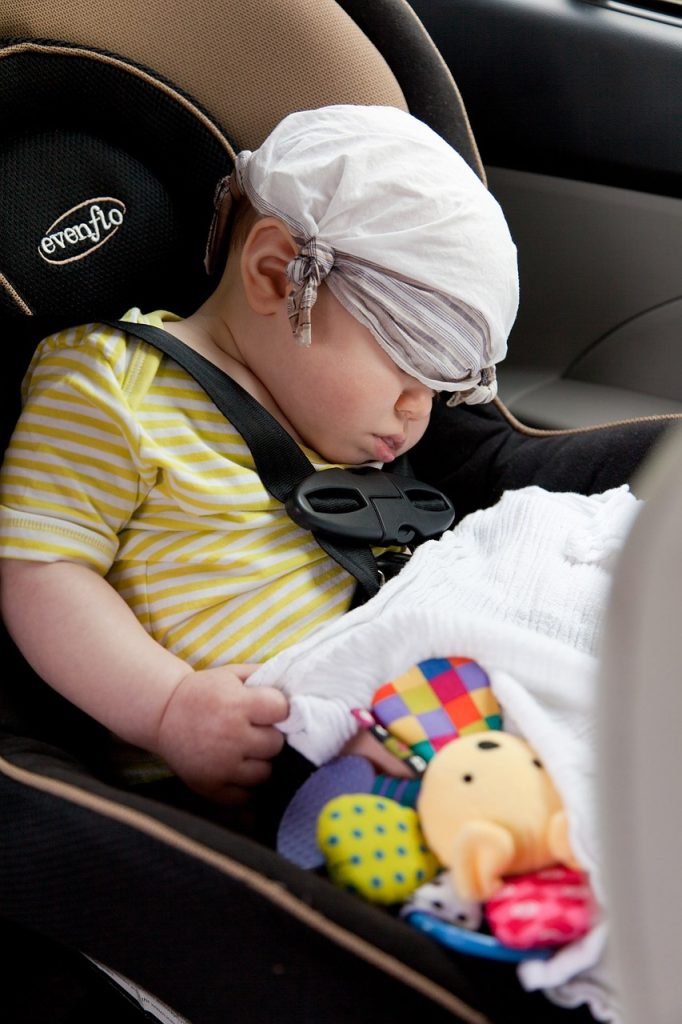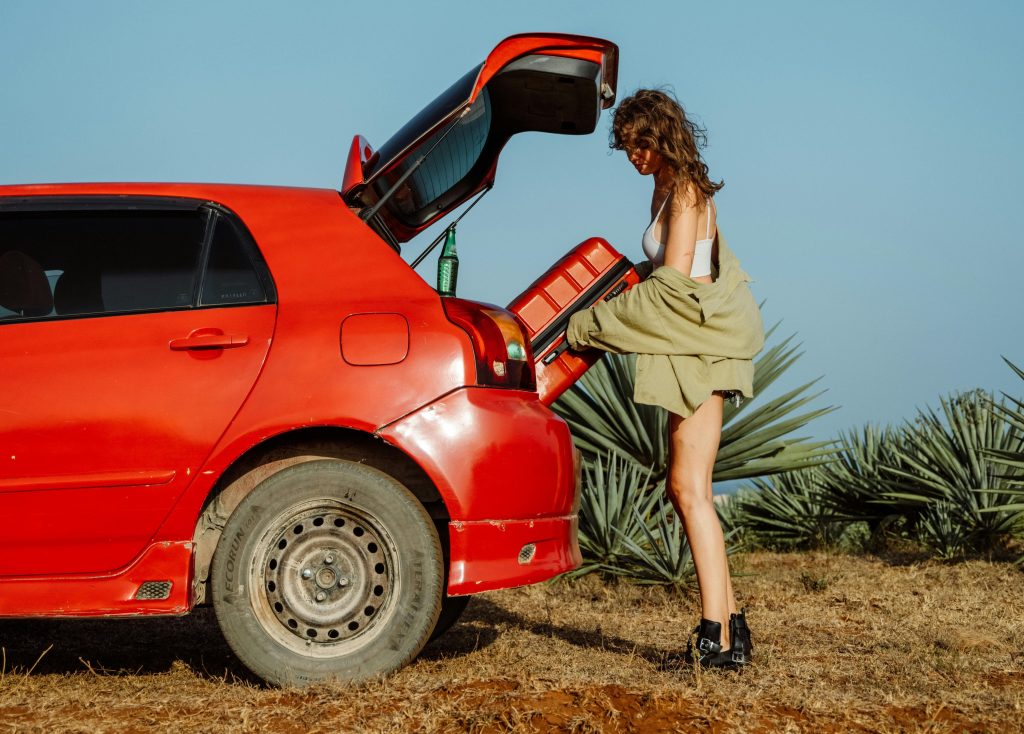Children can be erratic and unwieldy at the best of times. When you add driving into the mix, however, you’re in a completely different ballpark. If you’re not careful, you’ll end up driving down the motorway with them kicking and screaming in the backseat!
The roads are already unpredictable enough, so you’ll want to master the art of driving with children quickly. It’s your responsibility as the driver, after all, to keep all passengers safe inside your car. From the legal requirements of child car seats to general safety tips, we’re going to make you a expert in no time!
What are the rules?

Though there are exceptions, almost all children need to use a child car seat until they are 12 years old or 135cm tall—whichever comes first. Once they’re older than 12, or taller than 135cm, they can graduate to a standard seat belt. Now, the car seat you choose for the child can vary depending on their height or weight.
Child car seats based on height
These types of seats are also known as ‘i-Size’ seats. If you’re using one in your car, it needs to be rear-facing until the child is over 15 months old. You can switch to a forward-facing seat from then on. It’s important that the height-based seat is actually suitable for your child before you purchase it. We’d suggest making a note of how tall your child is when you start looking for one.
Additionally, the seat must be EU-approved for you to use it in the UK. You can figure this out quickly by searching for a label that has an encircled capital ‘E’ and ‘R129’.
Child car seats based on weight
If you’re choosing a car seat according to your child’s weight, you might have a few options to pick from, depending on the group they fall into.
0 – 0kg to 10kg (Lie-flat or ‘lateral’ baby carrier, rear-facing baby carrier, or rear-facing baby seat using a harness)
0+ – 0kg to 13kg (Rear-facing baby carrier or rear-facing baby seat using a harness)
1 – 9kg to 18kg (Rear- or forward-facing baby seat using a harness or safety shield)
2 – 15kg to 25kg (Rear- or forward-facing child car seat (high-backed booster seat or booster cushion) using a seat belt, harness or safety shield)
3 – 22kg to 36kg (Rear- or forward-facing child car seat (high-backed booster seat or booster cushion) using a seat belt, harness or safety shield)
As with seats based on height, you need to make sure that your weight-based child car seat is EU-approved. You can check by looking for a label with an encircled ‘E’ and ‘ECE R44’.
Manufacturers are now only allowed to make booster cushions approved as group 3. This will not affect any existing booster cushions that fall in group 2, however, so you’ll still be able to use them.
If you’re caught driving without the right child car seat, you could be looking at a £500 fine! It doesn’t matter if the child in question isn’t yours; as the driver, you are responsible.
Fitting a child car seat

Before you even think about driving off now that you’ve got the right child car seat, you first need to make sure you’ve fitted it correctly. For obvious safety reasons, you shouldn’t travel with a child car seat if it isn’t fitted and carefully secured with:
– A seat belt with a diagonal strap
– A lap seat belt (if the car seat is specifically designed for it)
– ISOFIX anchor points
– A disabled person’s seat belt or specific child restraint (if you’re travelling with children that have a disability or medical condition)
If you’re fitting a rear-facing seat at the front of your car, you’ll need to deactivate any front airbags—it’s illegal to do so otherwise. Additionally, you’re not allowed to fit child car seats to a side-facing seat.
If you have absolutely no idea how to fit a child car seat, don’t just wing it. Look up the instructions outlined by the seat’s manufacturer.
Are there any exceptions to the rule?
In almost all cases, children under 3 years old must have a child car seat when travelling. As with most rules, however, there are a few exceptions depending on the vehicle type and situation.
Travelling by taxi or minicab – If you’re not provided with a child car seat, the child can go without as long as they sit in the back. If they’re aged 3 or older, they must use an adult seat belt. If they’re younger, they must travel without the seat belt.
Travelling by coach – If a car child seat or seat belt isn’t available, children can travel without.
Travelling by minibus – If the minibus doesn’t have a car child seat or adult seat belt fitted, children must sit in the rear seat. Children over the age of 3 must use a child car seat if it’s available or use an adult seat belt.
Unexpected travel – If you’re on an “unexpected, necessary or short distance” journey, and a correct child car seat is unavailable, a child aged 3 or over can use an adult seat belt instead. Unless you’re in a licenced taxi/minicab, or the child travels on the rear seat without a belt, you can’t take a child under the age of 3 on an unexpected journey.
No room for third child car seat – Children under the age of 3 must use a child car seat. If you don’t have room for a third one in the back, then you’re allowed to use it in the front seat instead. Children over the age of 3 can sit in the back if they use an adult seat belt.
Tips for driving with children

Make sure your car is safe
The only thing that could make your car breaking down any more frustrating is if you have children with you. It’s already stressful enough without having to worry about the children being a safe enough distance away from the car, or having to put up with their incessant questions. As such, it might be a good idea for you to make sure your car will actually survive your trip.
If you’ve noticed a warning light on your dashboard, but have been carefully avoiding it, you’ll want to get it looked at ASAP. Underinflated or damaged tyres are common culprits of car accidents and breakdowns—so make sure you give yours a check. Crouch down to each tyre and keep an eye out for any cuts, bulges or puncture marks. Then, check their pressure and make sure they meet the requirements found in your vehicle’s handbook.
In case the worst does happen, and you end up stranded on a hard shoulder somewhere, you’ll also want to be sure you’ve got the right essential items in your car.
Pay attention when fitting the seat
Even if you’ve been fitting child car seats in your car for years, it’s important that you triple-check that everything is fitted according to the rules. If it’s an unfamiliar child car seat, have a look at the manufacturer’s instructions. You’ll also want to make sure that the belts used to fit the seat aren’t twisted or too loose. Remember, it’s always better to be safe than sorry.
Prepare for the trip

Failing to prepare is preparing to fail, as they say—or, when you’re travelling with kids in tow, preparing for a very stressful car journey. So, be sure you’ve sorted out a few key things before you set off.
For starters, you’ll need to begin with the dreaded question: “Does anyone need the toilet before we leave?”. Then, you’ll want to figure out a way to keep everyone entertained on the drive. Be careful what you choose, though. You will need something that will keep a child occupied for the duration of the drive, but not something that could potentially distract you, e.g., a gaming console that makes loud noises.
If you’re a good multi-tasker when you drive, you could play a few games of I-Spy (though it might get old pretty quickly) or throw on a playlist so they can do some karaoke. Alternatively, a drawing pad and a few pencils could be a good shout. Here, though, you run the risk of them dropping something beneath your seat.
Don’t forget the snacks and drinks either—they’re an absolute must when it comes to driving with children. You don’t want to be dealing with hangry children when driving. It could be life-threatening!
Lay out some ground rules
Before you set off, you might want to give the children a few ground rules to follow. To begin with, let them know that throwing things or shouting suddenly might distract you from driving. Make sure they understand how dangerous it can be. You’ll also want to dissuade them from starting any fights in the back. You can use the carrot or stick approach—it’s entirely up to you!
Once they reach a certain age, children can’t help but touch everything. As such, you might want to warn them against touching the door handles, seat belts or windows. Child locks were invented for a reason, so use them!
Take breaks
You might be perfectly content to sit in a car for hours without a break, but children certainly won’t be. If you’re taking children on a long trip, you will need to fit in a few breaks along the way. If you can, try to take breaks at a rest stop every couple of hours or so. Try to avoid stopping on hard shoulders or at the side of the road—you don’t want children to get too close to oncoming traffic.
You should use this time to get the children out of the car. Make them walk around for a few minutes or so to get some fresh air and give their legs a good stretch. You’ll also want to make sure you fit in toilet breaks and snack time.
Time it right
If the thought of herding boisterous children around in your car has you groaning in despair, you might want to think carefully about when you want to take your trip. More specifically, be sure to choose the right time of day to set off. If you get going in the early hours of the morning, for example, the children might be too sleepy to make too much of a fuss. If you’re really lucky, they might even nap through the entire journey!
Of course, if you do choose to leave early, you’ll need to get a good night’s sleep. You do not want to drive with children in your car if you’re drowsy.
